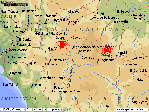
Range of Pinus rzedowskii (1). Locations shown are approximate; see Perry (2) for details on the difficulties of finding these pines in the wild. Basemap from Expedia Maps.
Common Names
Pino, ocote (2).Taxonomic notes
Description
"THE TREE - A medium-size pine 30-50 cm in diameter and 20-25 m high. The crown of mature trees is generally open and irregularly branched. In young trees the branches are arranged in regularly spaced whorls and the form is pyramidal.
"BARK - On young trees thin, smooth, grayish green. On large, mature trees it is thick and rough with deep horizontal and longitudinal fissures dividing the bark into rectangular plates that are rough, scaly and dark brown.
"BRANCHLETS - Slender, ashy gray, rather rough. However, bases of the leaf bracts are not decurrent; the leaves are borne along the entire branchlet.
"LEAVES - Flexible, slender, in groups of 3-4 and 5, mostly 4; 6-10 cm long, the edges finely serrate; stomata on the ventral surfaces only; resin canals 2-3, occasionally 4, external on the dorsal surface with occasionally 1 external on a ventral surface; fibrovascular bundle single. The fascicle sheaths form a rosette of recurved scales and are later deciduous.
"CONELETS - Erect on peduncles 1.5-2.0 cm long; scales thick, wide and recurved.
"CONES - Oblong, tapering slightly, symmetrical, pendent, borne singly and in pairs; 10-15 cm long and 6-9 cm wide when open; yellowish brown to lustrous ochre color when mature, ripening in the fall and soon deciduous; the peduncle 1.5-3.0 cm long, falling with the cone.
"CONE SCALES - Thick, hard, stiff, 15-22 mm wide; the apophysis subpyramidal with a prominent, horizontal keel, the apex acutely angled; umbo dorsal, small, dark brown, depressed, with a very small, downward-curved prickle. The apophyses and the umbo usually bear a small drop of clear amber resin.
"SEEDS - Dark brown to mottled; 4.0-4.5 mm wide, 8-10 mm long with an articulate wing 20-32 mm long and 8-11 mm wide; brown with darker brown striations. Cotyledons 9-14, mostly 10, 11 and 12.
"WOOD - Moderately hard, the heartwood lustrous pale brown, sapwood creamy white, not very resinous. The species is so rare and difficult to find that it is not used commercially" (2).
Range
Mexico: Michoacán: at 2100-2400 m elevation in the Sierra Madre del Sur, District of Coalcomán, in three disjunct localities, one near the village of Dos Aguas and the others approximately 40 km to the W: Cerro de Chiqueritas, Cerro Ocotoso, and Puerto del Pinabete.. Each location has only a few score trees.All populations "occur on steep, very rocky limestone soils... at elevations of 2040-2300 m; rainfall in the area is estimated to be 1,500 mm annually, almost all occurring during the period June-October; temperature is estimated to range from a minimum of -5°C to a maximum of 30°C in April just prior to the rainy season. On the best site, Puerto del Pinabete, the species was associated with P. pseudostrobus, P. herrerai, P. michoacana and P. oocarpa. At Cerro Chiqueritas and Cerro Octoso, both very rocky sites, no other pines were found with the small populations of P. rzedowskii" (2).
Big Tree
Oldest
Dendrochronology
Ethnobotany
Observations
"TO FIND P. rzedowskii - From Mexico City drive due west on Highway 15 to Morelia, capital of Michoacán State. At Morelia continue west to the city of Uruapan; at Uruapan turn south on Highway 37 to the small town of Nueva Italia. There turn west again to the town of Apatzingan, then go south again to the village of Aguililla. From Aguililla a narrow dirt road leads westward to the village of Dos Aguas. There a guide will be needed in order to locate the small, isolated stands of P. rzedowskii. The trip to Dos Aguas should be undertaken only during the dry season (November-March) and only in a vehicle with high clearance" (2).Remarks
P. rzedowskii "possesses many characters that are commonly associated with either one or the other of the two Pinus subgenera, Pinus and Strobus, but it has been assigned to subgen. Strobus. Its foliar morphology and anatomy, as well as preliminary cpDNA (chloroplast DNA) analyses, place it with P. cembroides in a highly distinct but as yet unresolved clade distant from other haploxylon pines. However, the bark, seed cones and seeds bear a close resemblance to certain species in subgen. Pinus, and indeed its small seeds with large wings render it anomalous with regard to all of the other Piñon pines, which have large wingless seeds. Farjon and Styles (1) attribute these characters, and in particular the development of small winged seeds, as perhaps reflective of convergent evolution; perhaps P. rzedowskii represents a piñon that has evolved away from dependence on animal vectors for seed dispersal (see P. albicaulis for more on animal dispersal of wingless pine seeds).The three small groups of pines in Michoacán are the only known populations in Mexico. Only one other Mexican pine is more rare and endangered viz. P. maximartinezii(2). This species is cataloged as endangered at the online World Conservation Monitoring Centre - Trees and by the IUCN Conifer Specialist Group. Perry notes that "In all three small groups of pines totaling ca. 30 ha, most of the mature trees had large fire scars and many trees were dead - evidence of repeated ground fires. In addition very little reproduction was noted, and it was difficult to find young trees under 12 cm in diameter. It is entirely possible then, that during the long dry season, this species could be wiped out completely by a severe fire" (2). The pine has not received formal protection in its native habitat (1).
Citations
(1) Farjon & Styles 1997.(2) Perry 1991.
[Pinus] [Pinaceae] [home]
This page is from the Gymnosperm Database
URL: http://www.geocities.com/~earlecj/pi/pin/rzedowskii.htm
Edited by Christopher J. Earle
E-mail:earlecj@earthlink.com
Last modified on 27-Feb-1999